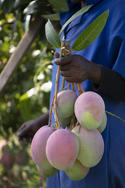
Mangoes are an alternate-bearing crop which means that crops vary in size from one year to the next. Good orchard management practices, such as fertilisation, can reduce crop differences. Though a change of 25% to 30% in yield between subsequent harvests are normally expected.
Yield of Mangoes
The yield of mangoes is measured in tonnes per hectare (the average of both ‘on’ and ‘off’ years) and depends on the age of the tree, mango cultivar, spacing of trees in an orchard, management practices (such as fertilisation) and other factors.
High-yielding cultivars include late-season Keitt - 30 tonnes/ha, early-season Tommy Atkins, Sensation and Jua, all 20 tonnes/ha and Keitt which can produce 15 tonnes/ha.
How to Harvest Mangoes
Mangoes are picked by hand, up to four times during the harvest season. The fruit is harvested at the so-called mature-green stage and must not be confused with ripeness. Mature mangoes will ripen after picking and ‘buy’s time’ for the handling and distribution of the fruit.
Maturity can be determined by using a colour chart for exported fruit or, for example, by checking for yellow colour change at the bottom of Jua and Sensation mangoes. Other factors such as shape, lenticels and indentation around the stem area can also help to determine the readiness of a specific cultivar for harvest. Regular visual inspections in the orchard are essential to determine optimum harvest time.
The stems of mangoes release a corrosive latex or ‘milk’ which can cause burn damage on the skin of the mangoes. Some producers use special grids or mould to allow the latex to drip, others choose to wash the fruit after harvest in a special solution to prevent latex burn.
The recommended time for harvesting mature fruits is from 09:00 to 15:00 to minimize latex flow, but this is not always practical.
Post-Harvest Handling of Mangoes
Mangoes are sorted in the orchard, according to classes 1 to 3. Class 3 fruit, particularly, is separated from the rest due to its skin damage, which is caused by birds, wind chafing marks or it is too small or large. These fruits are sent for processing such as juicing (small fruit) or drying (larger fruit).
Class 1 and class 2 fruit are sorted in the packing shed according to size, shape, skin appearance and damage and then packed into 2 kg or 4 kg cartons.
Anthracnose and stem-end rot are the two most important post-harvest diseases of mango fruits and hot water treatment (HWT) is used for pathogenic reasons in export fruit. HWT is not done in all areas of South Africa as some areas are less prone to these diseases. During HWT, green mature fruits are dipped for 5 minutes in water heated to 47℃. At this temperature, disease-causing organisms are killed without injuring the fruit.
Ripening of Mangoes
Mangoes are climacteric fruit. This means they will ripen after harvest. Mangoes can be harvested when mature but still hard and will be able to withstand the rigours of transport and repeated handling as it continues to ripen. As a climacteric fruit, mango ripening can be triggered and coordinated by treatment with ethylene gas.
Ripening changes in mangoes can occur at temperatures from about 10 to 30°C. Colour development is best at around 16°C, while flavour development is optimal at around 27°C.
Store mangoes at room temperature or ripen it by wrapping in a paper bag for two days. If cooled, it will not ripen, however, once ripe, mangoes can be stored in the fridge or frozen for up to six months.
Green (unripe) mangoes are picked to processing into atchar - is a spicy condiment, eaten with cold meats, curries and stew, for pickling and can be used thinly sliced in salads, marinated with herbs and spices, or pickled.
By Marinda Louw